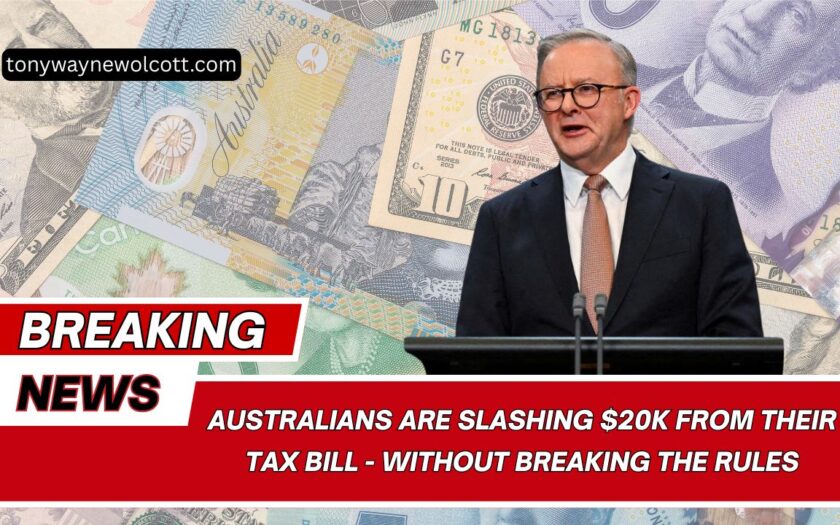For many Australians, tax isn’t just another bill — it’s often the largest expense of the year. High-income earners can hand over anywhere from $20,000 to $50,000 (or more) annually to the Australian Taxation Office (ATO). That’s more than most mortgages, school fees, or family holiday budgets.
]But here’s the good news: there are legal, ATO-compliant strategies that can cut your tax bill by $20,000 or more every year — without reducing your lifestyle or spending.
This isn’t about dodgy deductions or inflating work-related expenses; it’s about understanding how the tax system works and using legitimate strategies to make it work in your favour.
The Problem: Earning More Means Keeping Less
Australia’s progressive tax system means the more you earn, the higher the percentage of tax you pay. If you earn six figures, you could be losing nearly half of every additional dollar to tax. Promotions, bonuses, and salary increases are great — until you see your after-tax income.
With the right planning, you can reduce your taxable income, keep more of what you earn, and invest those savings to grow your wealth.
The 3 High-Impact Strategies to Slash Your Tax Bill
While there’s no one-size-fits-all fix, combining these three proven tactics can drastically reduce your tax bill:
- Negative Gearing
- Debt Recycling
- Tax-Effective Investing
1. Negative Gearing
Negative gearing occurs when the expenses on an investment — like interest on a loan — exceed the income it produces. The resulting loss can be offset against your taxable income, reducing the tax you pay today.
This strategy is often used with property but can also apply to other investments, such as shares. Over time, the asset’s capital growth can more than outweigh the early losses, creating a profitable long-term position.
Key points to remember:
- Focus on quality, growth-oriented assets.
- Ensure you have a cashflow plan to manage short-term losses.
- The goal is to generate long-term wealth while reducing tax in the short term.
2. Debt Recycling
If you have a home loan, debt recycling can turn non-deductible mortgage debt into tax-deductible investment debt.
Here’s how it works:
- Use equity in your home to invest in income-producing assets like shares.
- The investment loan interest becomes tax deductible.
- As you repay your home loan, you gradually replace it with tax-deductible debt tied to investments.
Example:
With an average Australian mortgage of $660,000 at 6% interest, debt recycling could generate $39,600 in annual tax deductions. Over time, you reduce your bad debt while building an investment portfolio.
3. Tax-Effective Investing
Owning investments in your own name can push you into higher tax brackets. Tax-effective structures — like family trusts, investment bonds, companies, or superannuation — can significantly lower the tax on investment income.
Benefits include:
- Spreading income across multiple family members in lower tax brackets.
- Capping tax rates on investment income (e.g., investment bonds taxed at 30%).
- Deferring or eliminating capital gains tax after specific holding periods.
Because these structures are complex, professional advice is crucial to ensure the setup aligns with your goals and is fully compliant.
How These Strategies Work Together
Individually, each of these methods can reduce your tax bill. But combined, they can:
- Cut your annual tax bill by $20,000+.
- Create passive income streams.
- Accelerate wealth growth without increasing your salary.
Over 10 years, this approach can lead to six-figure savings and significantly higher net worth.
Tax Saving Potential — Example
| Strategy | Potential Annual Tax Saving | Key Benefit |
|---|---|---|
| Negative Gearing | $8,000 – $12,000 | Reduces taxable income today, builds long-term equity |
| Debt Recycling | $10,000 – $15,000 | Converts non-deductible debt to deductible debt |
| Tax-Effective Investing | $5,000 – $10,000 | Lowers investment income tax and capital gains tax |
| Total Potential | $20,000+ | Combined impact can significantly cut tax annually |
Figures are estimates and depend on income, assets, and individual circumstances.
Why This Isn’t About “Dodging” Tax
These strategies are 100% legal and align with ATO guidelines. They’re about structuring your finances efficiently, not hiding income or making false claims.
The difference between paying maximum tax and smart tax is knowledge and planning. Wealthy Australians often use these strategies because they understand that earning more is good, but keeping more is better.
Paying tax is unavoidable, but overpaying isn’t. By using negative gearing, debt recycling, and tax-effective investing, Australians can legally slash $20,000+ from their tax bill each year.
The saved amount can then be invested, creating a compounding effect that accelerates financial freedom.
If you’re serious about cutting your tax and building wealth, now is the time to seek expert advice and create a strategy tailored to your situation. The sooner you start, the bigger the long-term payoff.
FAQs
Is negative gearing risky?
Yes, if poorly managed. Always invest in quality assets and have a cashflow plan to manage short-term losses.
Can debt recycling work for anyone?
It works best for homeowners with equity and stable income who are willing to invest for the long term.
Do I need an accountant for tax-effective investing?
Yes. These structures can be complex, and professional advice ensures compliance and maximises tax benefits.

